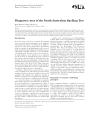
From the 17th century onwards, pirates took a few on board for food, but the arrival of whaling ships in the 1790s saw this exploitation grow exponentially. Relatively immobile and capable of surviving for months without food or water, the tortoises were taken on board these ships to act as food supplies during long ocean passages. Sometimes, their bodies were processed into high- grade oil. This inhospitable environment is home to the giant Galapagos tortoise. Some time after the Galapagos’s birth, around five million years ago, the islands were colonised by one or more tortoises from mainland South America. As these ancestral tortoises settled on the individual islands, the different populations adapted to their unique environments, giving rise to at least 14 different subspecies. Island life agreed with them. In the absence of significant predators, they grew to become the largest and longest-living tortoises on the planet, weighing more than 400 kilograms, occasionally exceeding 1,8 metres in length and living for more than a century.īefore human arrival, the archipelago's tortoises numbered in the hundreds of thousands.


An airborne reintroduction programme has helped conservationists take significant steps to protect the endangered Galapagos tortoise.įorests of spiny cacti cover much of the uneven lava plains that separate the interior of the Galapagos island of Isabela from the Pacific Ocean. With its five distinct volcanoes, the island resembles a lunar landscape. Only the thick vegetation at the skirt of the often cloud-covered peak of Sierra Negra offers respite from the barren terrain below.


 0 kommentar(er)
0 kommentar(er)
